- Home/
- Comparisons/
- Breakfast Takeaway & Delivery/
- Irish Breakfast vs English Breakfast
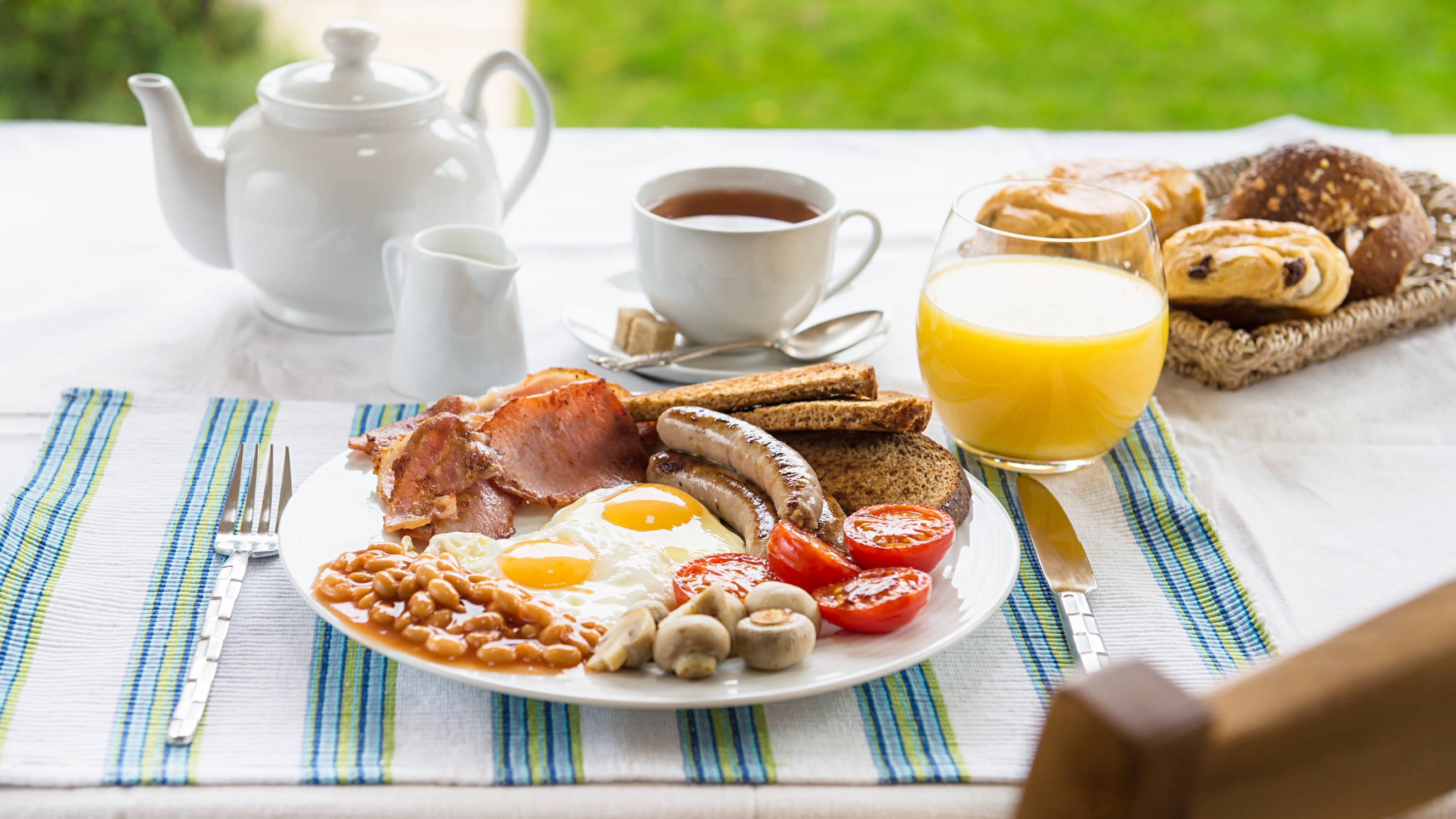
Irish breakfast vs English breakfast: What’s the difference?
Comparing Irish and English breakfast based on origin, core ingredients, and more
Have breakfast deliveredPublished on

Written by Ana K
Contributor
Read more about our contributor
Key Facts
- An Irish breakfast is a morning meal composed of meats like black and white pudding, sausages, and bacon, as well as eggs and tomatoes. It is accompanied by Irish soda bread and drinks like tea and orange juice.
- An English breakfast is a meal eaten in the morning made up of baked beans, potatoes, and mushrooms. It also includes sausages, bacon, eggs, tomatoes, and buttered toast, as well as tea or coffee.
The Irish and the English take their breakfast seriously, loading it with proteins, carbs, and fats to help them jump-start the morning. They have even fashioned their own traditional versions of the most important meal of the day, resulting in the Irish breakfast vs English breakfast debate.
At first glance, they appear to be the same dish. However, as this guide shows, several things make them distinct from one another.
What is an Irish breakfast?
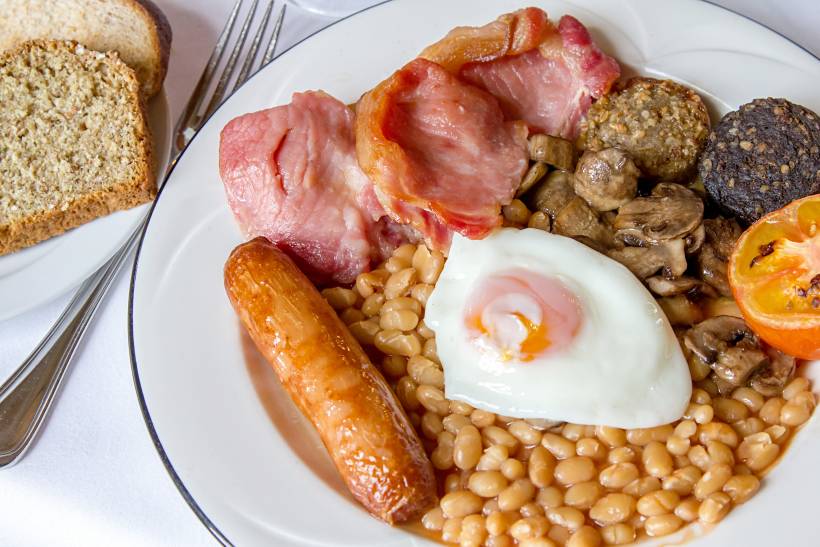 A full Irish breakfast, featuring fried egg, baked beans, crispy bacon, soda bread, grilled tomatoes, and both white and black pudding (Source: iStock)
A full Irish breakfast, featuring fried egg, baked beans, crispy bacon, soda bread, grilled tomatoes, and both white and black pudding (Source: iStock)
An Irish breakfast, also known as an Irish fry-up, is a filling meal composed of eggs, bacon, sausages, grilled tomatoes, mushrooms, and Irish soda bread. The beverages that typically go with it are Irish breakfast tea and orange juice. But what makes it characteristically Irish compared to other traditional breakfasts is the addition of two types of sausages: white pudding (which contains a type of grain, such as oatmeal) and black pudding (which contains pig or cow blood).
What is an English breakfast?
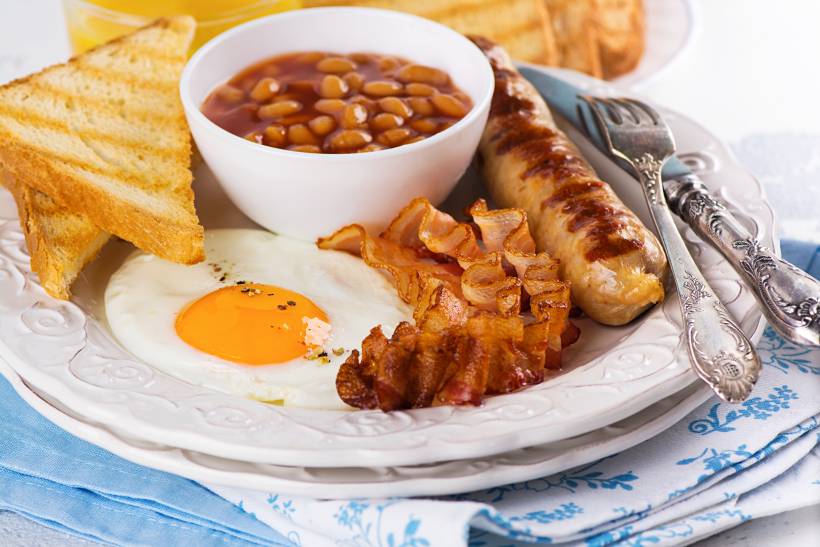 A hearty English breakfast of fried egg, crispy bacon, savoury sausage, buttered toast, and baked beans (Source: iStock)
A hearty English breakfast of fried egg, crispy bacon, savoury sausage, buttered toast, and baked beans (Source: iStock)
An English breakfast is also a morning meal, although many consume it at different times of the day. It is made up of back bacon, sausages, eggs, potatoes, mushrooms, and tomatoes. It also typically comes with fried bread in the form of buttered toast. One integral element of an English breakfast is a serving of baked beans. Most people have it with English breakfast tea, coffee, or both.
English breakfast vs Irish breakfast: How are they different?
In this section, we’ll be exploring a couple of things that show the difference between Irish and English breakfasts:
In terms of origin
What is the origin of the full English breakfast? According to the English Breakfast Society, the Norman Conquest of 1066 paved the way for the creation of the English breakfast; the Anglo-Saxons resisted the creeping cultural influence of the Norman French on the British Isles by upholding their habits and customs, including their traditional morning meal and its contents. Over time, it became a widespread tradition to have the English breakfast served on the estates of the landed gentry and those with noble titles before going hunting.
Meanwhile, the Irish breakfast has a more conflict-free and humble origin—the dining tables of farm workers centuries ago who needed an easy-to-make yet substantial breakfast before performing agricultural labour. They developed the meal after the English introduced it in the 14th century.
In terms of core ingredients
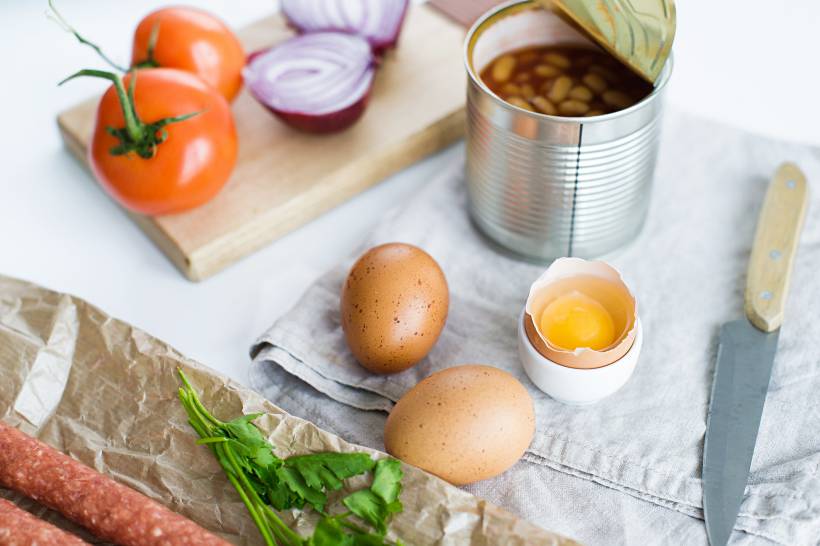 Fresh ingredients for a traditional English breakfast: tomatoes, eggs, beans, onions, and sausages (Source: iStock)
Fresh ingredients for a traditional English breakfast: tomatoes, eggs, beans, onions, and sausages (Source: iStock)
What is in a full English breakfast? Some traditional British breakfast foods are eggs, bacon from the back of a pig, sausages, tomatoes, mushrooms, potatoes, and toast with butter. It also includes baked beans, which is what separates it from other types of breakfasts. Other components you may expect in this meal are bubbles and squeaks, hash browns, and pudding sausages.
But what is in an Irish breakfast? A traditional full Irish breakfast has very similar elements. However, the inclusion of two protein sources—white and black pudding—makes it distinctly Irish.
In terms of cooking method
The English breakfast, like several traditional British breakfast foods, is typically cooked in a very straightforward way; it involves using a saucepan to fry all the ingredients, from the eggs and mushrooms to the sausages and even the bread. A traditional Irish breakfast may be fried, too, but grilling its components is also a preferred cooking method for many.
In terms of condiments
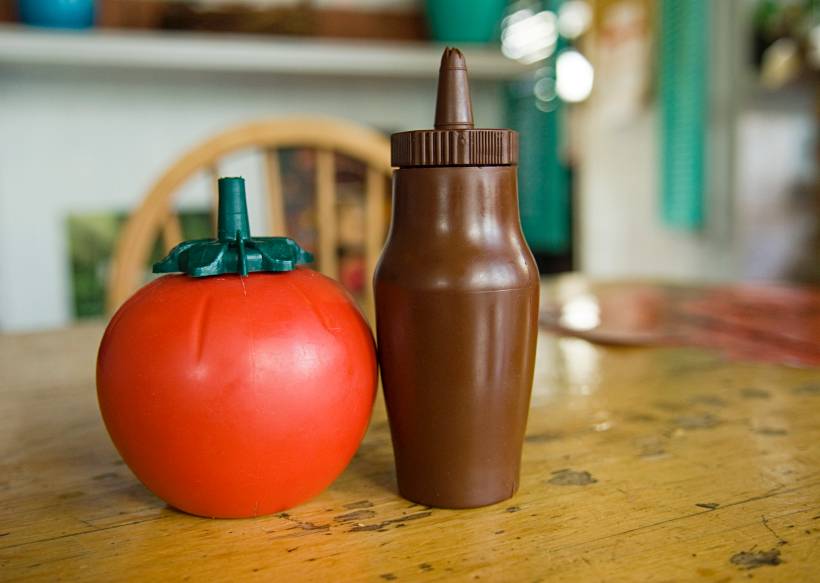 Ketchup and brown sauce ready for use (Source: iStock)
Ketchup and brown sauce ready for use (Source: iStock)
A full Irish breakfast vs a full English breakfast highlights one type of condiment in particular—the brown sauce. It is a savoury, sweet, and slightly spicy sauce made of malt vinegar, molasses, soy, tomatoes, dates, and tamarind. Meanwhile, an English breakfast typically includes both ketchup and brown sauce. For some people’s taste buds, hot sauce and mustard also perfectly complement the meal.
In terms of bread selection
Another difference between English and Irish breakfast is bread type. A full English breakfast would normally feature fried wholemeal or white bread. Meanwhile, enjoyers of Irish breakfast tend to incorporate slices of Irish soda bread into the meal. One popular type of this baked good is Irish brown bread, which is made of white and whole wheat flour and has a slightly sweet flavour.
In terms of tea pairing
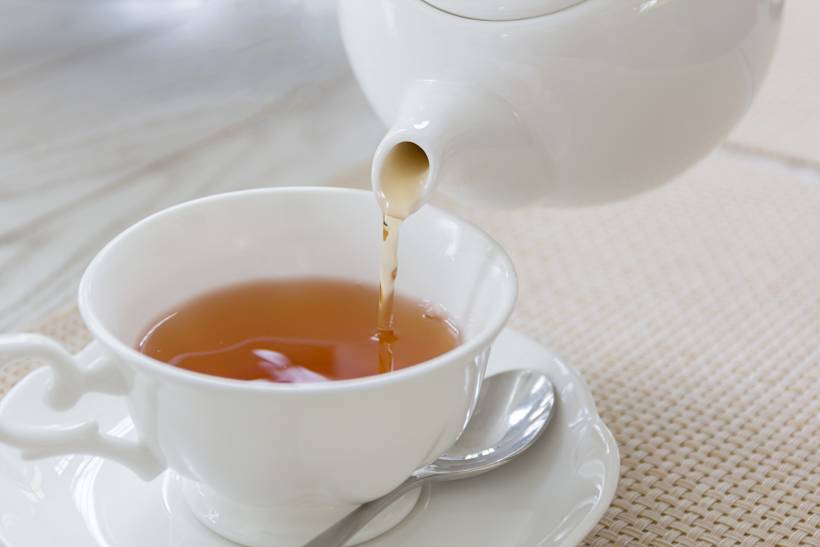 Comfortingly hot tea being poured into a cup (Source: iStock)
Comfortingly hot tea being poured into a cup (Source: iStock)
Tea pairings for these morning meals aren’t really complicated—the Irish breakfast goes with the Irish breakfast tea, while the English breakfast goes with the English breakfast tea. The former has an Assam base, is more robust in terms of flavour, and has a red tinge. The latter, on the other hand, is mostly made of Ceylon tea. Both black teas can be mixed with milk and sugar.
In terms of serving time
As one can deduce from their names, both Irish and English breakfasts are customarily served in the morning. However, it is not uncommon for an authentic English breakfast to be consumed at any time of the day. As playwright Somerset Maugham once said, ‘To eat well in England, you should eat breakfast three times a day.’
In terms of cultural impact
The Irish breakfast is truly representative of its nation, and it is not just because of its name. It is treated as a comfort food, a hangover cure, and a go-to for Irishmen abroad who are craving something from home. The English breakfast, meanwhile, has become popular not just for the people of England but also for citizens of other countries. It is not surprising to find it as a breakfast offering in hotels, restaurants, and other establishments across the globe.
Enjoy the Irish or English breakfast experience through Airtasker
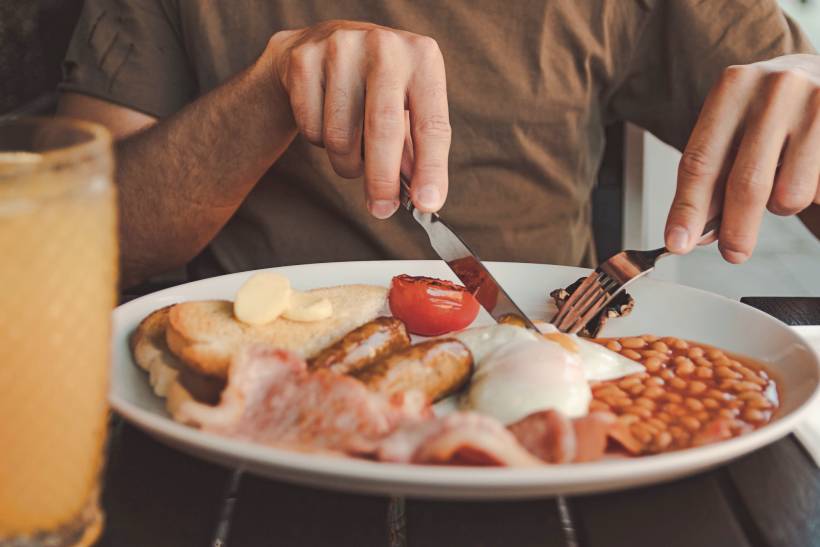 A man indulging in a freshly cooked English breakfast (Source: iStock)
A man indulging in a freshly cooked English breakfast (Source: iStock)
There’s no need to control your appetite for an English or Irish breakfast any time you’re craving it. Airtasker has service providers that offer food delivery services, whether it’s in the morning or at any other time of the day. Simply post a task with all the relevant details on the website and wait for a Tasker to contact you regarding your Irish or English breakfast order.
You may even use Airtasker to connect with a home chef who can replicate traditional Irish breakfast recipes and English ones.
Learn more about our contributors

Written by Ana K
Contributor
Ana always puts a premium on accuracy, clarity, and style when writing—a practice that her English degree has instilled in her. She excels at covering topics related to pet care, home and interior design, and food, which count among her varied interests. She also enjoys nature and street photography, as well as travelling. Overall, Ana uses her love for research to engage Airtasker readers with fun, practical content.
Irish breakfast vs English breakfast
|
Irish Breakfast |
English Breakfast |
|
|---|---|---|
Origin |
Can be traced back to the 14th century |
Dates back to the Norman Conquest of 1066 |
Core Ingredients |
White and black pudding, the staple ingredient, is added to eggs, bacon, sausages, tomatoes, and mushrooms |
Baked beans, the staple ingredient, is added to eggs, back bacon, sausages, potatoes, tomatoes, and mushrooms |
Cooking Method |
Either grilled or fried |
Mostly fried |
Condiments |
Brown sauce |
Ketchup and brown sauce, sometimes mustard or hot sauce |
Bread Selection |
Irish soda bread, particularly the brown bread variety |
Fried toast with butter |
Tea Pairing |
Irish breakfast tea |
English breakfast tea |
Serving Time |
In the morning |
Mostly in the morning but not uncommon to be served at other times of the day |
Cultural Impact |
Depicts the Irish people’s ties to their nation, even when they are abroad |
Reflects the influence of England on the rest of the world |
FAQs on Irish and English breakfasts
One element unique to a Scottish breakfast is the Lorne or square sausage. Other Scottish fares may also be present, such as tattie scones, haggis, oatcakes, and fruit pudding.
A traditional Welsh breakfast, unlike the Irish and English ones, typically has cockles and laverbread. A cockle is a mollusc found on Wales’s sandy beaches. Meanwhile, laverbread—not a type of bread, surprisingly—is a food product made of seaweed.
Various supermarkets, small groceries, local butchers, and online stores in New Zealand offer different brands of black and white pudding for people who want to have their own Irish breakfast dishes. Some local businesses even produce award-winning puddings.
Yes, a quick Google search of restaurants in New Zealand that serve Irish and English breakfast reveals several establishments that do so.
Find breakfast takeaway & delivery services, fast
Post a task
Related articles